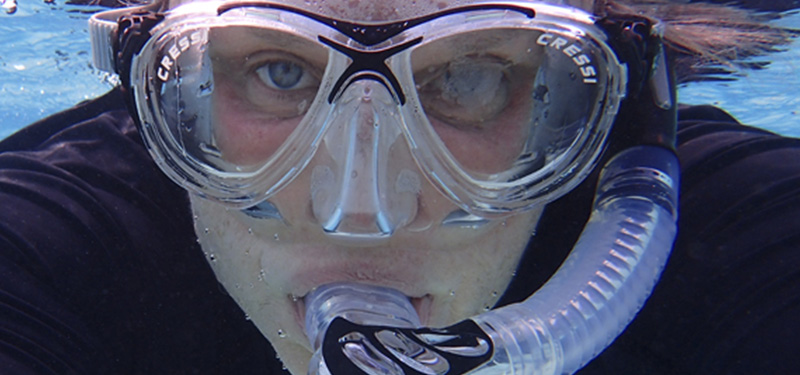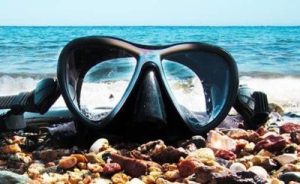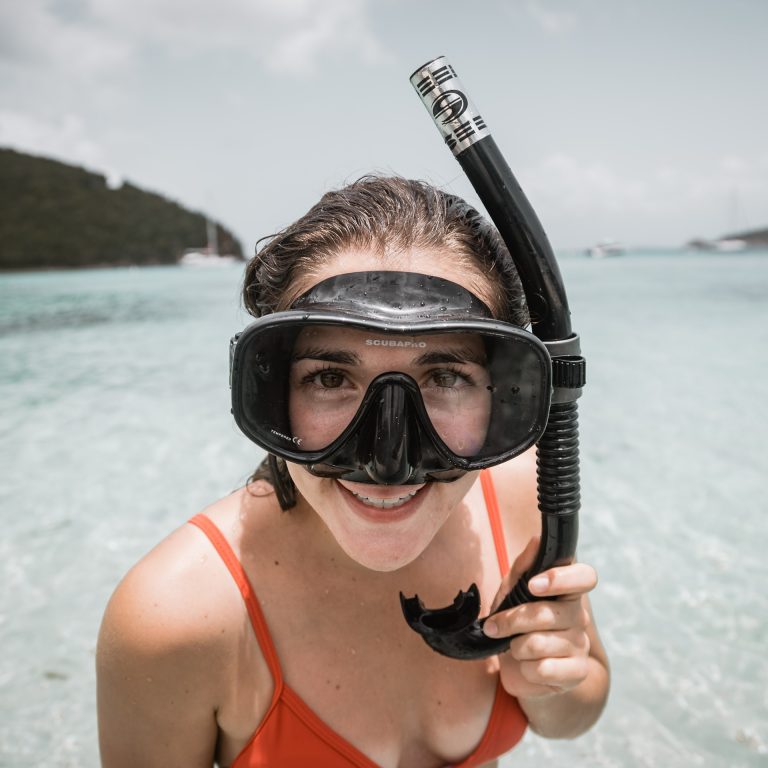Snorkeling is a wonderful way to explore the beauty and diversity of the underwater world. But to enjoy it fully, you need a snorkel mask that gives you a clear and comfortable view. However, sometimes, your mask may get foggy or dirty, which can ruin your experience and even put you at risk. That’s why it’s important to learn how to clean a snorkel mask and prevent fogging before you dive in.
In this article, we will teach you how to prepare your mask for snorkeling, whether it’s new or old or borrowed from a dive shop. We will also share some tips on how to take care of your mask after each use and store it properly.
By following these simple steps, you can make sure that your mask will last longer and give you a clear and fog-free view of the amazing marine life. Snorkeling is a fun and relaxing activity that can enhance your travel experience, but only if you can see clearly. So, let’s get started with how to clean a snorkel mask and prevent fogging.
How To Clean A Snorkel Mask In 5 Minutes Or Less?
To prevent any dirt or salt from damaging your mask, wash it with clean water as soon as you can. Use a gentle dish soap or a cleaner made of silicone to soak your snorkeling mask in warm water. (Do not use alcohol or petrolatum) The water should be pretty cool. Otherwise, your mask might change its shape.
1. Clean a Snorkel Mask Lens With Toothpaste

One of the main culprits behind a foggy snorkel mask is dirt and grease. These substances can attract water molecules and make them stick to your mask lens, blocking your view of the underwater wonders. This can happen to any mask, even a brand-new one. That’s because new masks usually come with a protective layer of silicone grease on the lens, which is suitable for shipping and handling but bad for fog-free diving.
To avoid this problem, clean your snorkel mask lens before entering the water. And you don’t need any fancy or harsh cleaners for this task. You only need some toothpaste, preferably the paste type (not gel), like the classic Colgate toothpaste. Toothpaste is a mild and effective cleaner that can remove dirt and grease from your mask lens without damaging it.
Here’s how to clean a snorkel mask with toothpaste:
- Put some toothpaste on your snorkel mask lens’s inside (and outside, for good measure).
- Use a microfiber cloth (something soft and gentle) to rub the toothpaste around and gently clean the snorkel mask. Avoid using your finger or a brush, as they may leave oil or scratches on the lens, making fogging worse.
- After lightly cleaning the snorkel mask, use warm water to rinse off all the toothpaste.
- Wipe the lens dry with a clean part of your microfiber cloth.
You may need to repeat this process a few times if your mask is new or dirty. But once it’s clean and shiny, you have a clean snorkel mask and are ready for the next step.
2. Apply A Simple Anti-Fog Spray To The Inside Of Your Mask
To prevent fogging, we need to apply an anti-fog solution to the lens of our snorkel or scuba mask. This solution is made of a mild soap, such as baby shampoo such as Johnson’s – Baby Shampoo, and clean water. The soap will remove any dirt and oil that may attract water droplets and cause fogging.
The soap to water ratio could be more precise, but you can try about 5 drops of baby shampoo for every 2 tablespoons. You just need enough water to dilute the soap and make it easy to spray.

A spray bottle is a handy tool for applying our anti-fog solution. You can use any empty or almost empty spray bottle at home. Just rinse it well and fill it with water and soap. Then, spray a thin solution layer on the inside of your mask’s lens.
If you don’t have a spray bottle, apply the solution by pouring some on the lens and moving the mask around. But be careful not to touch the lens with your fingers, as they may leave oil that can cause fogging.
After spraying the solution on the inside of your mask’s lens, rinse it with water. Don’t overdo it; you want to leave a thin layer of the anti-fog solution on the surface to prevent dust, oils, and fog from sticking to it. Also, try to do this before you go snorkeling; bringing the anti-fog solution to the beach will help.
The sooner you apply the solution before diving, the better. This way, you can ensure your mask is well protected, and no dirt or oil can get on it.
Important note
The anti-fog solution should not be used on the exterior of the mask. The first reason is that it would be useless because fog wouldn’t start building up on the exterior while underwater, and the second is that we shouldn’t introduce any foreign elements like that into the ocean.
What About Buying Mask Anti-Fog Sprays?
You might have come across some products that claim to be specially designed for anti-fogging your snorkel or scuba mask. Do they work? Yes, most of them do work.
However, you might have to pay more for these products (although they are not very expensive, usually around $10 per bottle), and they might need to be more eco-friendly. Try the baby shampoo method first because it is cheaper and less environmentally harmful.
If the baby shampoo anti-fog treatment does not work well for your mask, you should consider buying an anti-fog spray. But make sure you choose a reef-safe spray (i.e., not damaging to reefs or marine life), like Stream2Sea’s Reef Friendly Mask Defog. It is widely used and friendly to the fishes.
[This is also an excellent time to remind you that we should all use ocean-friendly sunscreens, which you can find in our guide on the best reef-safe sunscreens.]
Rinse Your Mask After Every Snorkel
It is important to rinse your mask with fresh water after every snorkeling session. This applies to anything you take into the water, such as swimwear, wetsuits, action cameras, etc.
The salt in the ocean water can damage your mask’s plastic and silicone parts if you don’t rinse it well. You should wash your mask thoroughly to prevent the seal, the fit, the straps, and other components from deteriorating.
This is especially true for full-face snorkel masks with a more complex design and structure. You should take apart your mask after each dive (the valve should detach from the top of the face dome) and run water through the valve, the lens, the frame, and the silicone skirt.
Why is Mask Cleaning Important?

Mask cleaning is essential for several reasons. Here are some of them:
- Visibility: When you wear a snorkel mask, your eyes are protected from water, and you can see clearly. Visibility is slightly altered while underwater, so you don’t want to make it worse by having a dirty or foggy mask. A clean mask will allow you to enjoy the beauty of the underwater world without any distractions.
- Fogging: This is the most common problem experienced by snorkelers. Fogging occurs when water vapor condenses inside your mask lens, creating a misty layer that obscures your vision. Fogging can be caused by dirt, oil, or residue on your mask lens or by the temperature difference between your face and the water. A clean mask will prevent fogging by removing any substances that may attract water droplets and by creating a smooth and even surface on your lens.
- Durability: A snorkel mask is an investment that you want to last for a long time. A dirty mask can damage your mask’s plastic and silicone components, primarily if you use it in saltwater. Saltwater can corrode the mask or affect its seal, fit, or adjustability. A clean mask will prevent damage by rinsing off any salt or sand that may get trapped in the mask. You should also store your mask in a cool and dry place, away from direct sunlight or heat sources.
- Hygiene: A snorkel mask is something you put on your face, so you want to ensure it is hygienic. A dirty mask can harbor bacteria or germs that may cause infections or irritations on your skin or eyes. A clean mask will prevent hygiene issues by disinfecting the mask with a mild soap and water solution or a UV sterilizer. You should also only share your mask with others if you disinfect it before and after each use.
How To Keep Your Mask From Fogging During Snorkeling
To keep your mask fog-free while in the water, you can also do some things besides cleaning and treating your mask beforehand. Here are some tips:

- Keep your mask away from direct sunlight before entering the water. This will prevent the lens from getting too hot and creating condensation when it touches cold water.
- When you submerge your face in the water, the mask lens will cool down quickly, and any fogging caused by the warm air inside the mask will disappear.
- If you still have fog in your mask, you can use your saliva as a last resort. Spit on the inside of the lens and rub it gently if you can safely take off your mask while treading water.
- While it may sound gross, spitting out any moisture in the air during your dive will help you see better.
What To Do After Snorkeling?
As I mentioned, you should rinse your mask with clean water after every use. Take apart the parts that can be separated (like the valve on a full-face snorkel mask) and wash them well. This will stop the salt water from corroding your mask and make it last longer.
You should also clean and anti-fog your mask again after each use in the water, especially if fogging continues. This is a normal part of mask care that helps prevent dirt and grease from accumulating.
How To Clean A Snorkel Tube?
These days, the snorkel tube may be removed from the mask on most snorkeling sets. Because the tube’s empty inside, keeping it clean might be challenging. In addition, bacteria have a vast surface area on which to cling. A longer soaking time for a snorkel tube is therefore recommended.
- To clean a snorkel tube, soak it in a soap and water solution for a few hours or overnight. This will help remove any dirt, oil, or bacteria from the inside of the tube. You can use any mild soap, such as dish soap or baby shampoo, and a large bowl or bucket of water. Make sure to squeeze out any air from the tube so the solution can reach all parts. You can also use a long and thin brush to gently scrub the inside of the tube if you have one.
- After soaking, rinse the tube with clean water to remove any soap residue. You should rinse both the inside and the outside of the tube thoroughly. You can use a faucet or a hose to run water through the tube.
- The last step is to dry the tube completely before storing it. You can use a dish towel to wipe the outside of the tube and try to reach the inside as much as possible. You can also shake out excess water from the tube and let it air dry. Drying the tube is essential to prevent any mold or mildew from growing inside it.
(You can learn more about cleaning your snorkel and keeping dry snorkel valves working correctly in our guide, How to Clean a Snorkel Tube: 3 Quick Steps & 2 Surprises.)
More actionable Tips
- Don’t ever place the snorkel mask on the visor. The visor could get scratched if the ground is stony, reducing visibility and the mask’s life span.
- Never leave the mask out in direct sunlight. The silicone around the edge of a snorkel mask degrades when exposed to sunlight. In some cases, the boundary may undulate and then become less dense.
- An exemplary storage spot should be dry, cool, and out of the way of both heat and cold. Snorkel masks should be kept dry, away from excess moisture.
- To prevent your snorkel mask from misting up, it is essential to keep it on at all times. When glass comes into touch with humid air, fogging occurs. This is possible when using a traditional snorkel mask and exhaling through the nose. The visor can fog up if you take your snorkeling mask off or rest it too high on your forehead.
- Sun, sea, and snorkeling are natural companions. On the other hand, the snorkel must never be forgotten on the beach. Sand can get caught in the mask. Because of the mask’s movable joint, wearing a full-face snorkel mask requires extra caution. The mask would become unsuitable in no time if exposed to sand.
- The majority of masks come with a set of maintenance instructions from the manufacturer. Always start with these guidelines. The instructions provided by the manufacturer should be followed for cleaning the snorkel mask.
- Those who take the time to clean their snorkel mask before each usage and thoroughly rinse it with detergent after each trip will be well on their way to becoming experts at the sport. The most important thing is that the mask is clean and clear of debris like dust, sand, salt, or bacteria. This extends the product’s useful life. Fogging can be avoided with the use of anti-fog spray and toothpaste.
- After washing, a soft towel or disposable towel is used to dry the mask. Do not use your bare fingers to clean the snorkel mask. In addition to contributing to the mask misting up, the greasy fingerprints you leave behind can collect dirt.
FAQs
Conclusion?
A snorkel mask is an essential piece of equipment for snorkeling, as it allows you to see the underwater world clearly and comfortably. However, a snorkel mask can get dirty, foggy, or yellowed over time, affecting visibility and enjoyment. Therefore, you must know how to clean a snorkel mask properly and prevent fogging.
This article shows you how to clean a snorkel mask using different methods and materials, such as toothpaste, baby shampoo, bleach, vinegar, baking soda, and anti-fog sprays. We have also given you some tips on maintaining your mask after each use and storing it correctly. By following these steps, you can ensure that your mask will last longer and give you a clear, fog-free view of the marine life.
Snorkeling is a fun and relaxing activity that can enrich your travel experience, but only if you can see clearly. So, treat your mask well, and it will serve you well. This article has helped you learn how to clean a snorkel mask and prevent fogging. Happy snorkeling!







